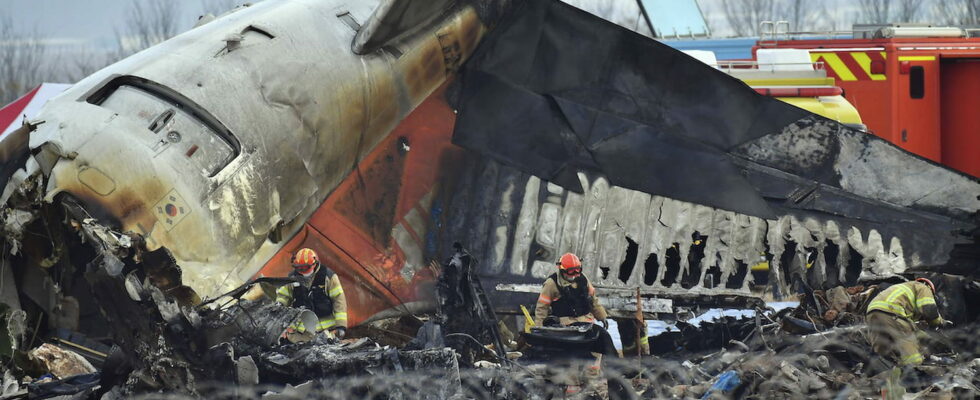The plane landed on its belly before ending its journey by hitting a concrete wall on Sunday, December 29. The final toll is 179 dead. Two people survived.
Four days after the tragedy in Azerbaijan, South Korea experienced the most serious crash in its history on Sunday December 29 at Muan airport, located nearly 300 km from Seoul. The accident took place while the plane, a Boeing 737-800 of the South Korean low-cost airline Jeju Air, was landing. On Sunday, local authorities argued that the crash could have been caused by the plane’s collision “with birds” as well as “weather conditions”, while remaining cautious: “However, the exact reason will be announced at the end of a joint investigation.”
Before the crash, the plane had sent out a distress message after a first landing attempt, when the control tower had warned the crew that the plane had been struck by birds. According to Jeju Air general manager Kim E-bae, the aircraft showed no signs of malfunction. On social networks, the video of the tragedy was widely distributed.
INFO – #SouthKorea : Jeju Air Boeing 737-800 crash in South Korea:
2 survivors, 120 bodies found
The plane crashed 2 minutes after a Mayday
This aircraft made an emergency landing 48 hours ago during a flight between Jeju and Beijing. pic.twitter.com/AkUI6tjSAY— FranceNews24 (@FranceNews24) December 29, 2024
But the day after the tragedy which cost the lives of 179 people, South Korea announced that it was launching a “full inspection” of some 101 Boeing 737-800s that the country’s companies use, the same model as the plane. which crashed in Muan. Investigations which must be held until January 3 and which would not be totally unrelated to the problem linked to the landing gear encountered this Monday morning by another Boeing 737-800 from Jeju Air, relays The World.
“The captain communicated with ground control and, after taking additional measures, the landing gear returned to normal operation. However, it was decided to return to the airport” of Gimpo ( northwest of South Korea), a Jeju Air official told the South Korean press. Remember that the landing gear had already been pointed out on Sunday.
Two survivors among the 181 passengers
The plane that crashed on Sunday was carrying 181 people, including six crew members, from Bangkok, Thailand. Only two people were of Thai nationality, the other passengers were all South Koreans. The toll is dramatic: 179 dead, aged 3 to 78, and only two survivors.
Both were crew members of the Jeju Air plane. The steward, aged 32 or 33 depending on the sources, suffered multiple fractures, but would have been able to communicate with emergency services. He was hospitalized in intensive care. The second survivor is a flight attendant aged around twenty. She suffered injuries to her ankle and head. His days are not in danger. The two survivors were hospitalized in Seoul, relayed in particular Yonhap.
While the emergency landing still seems to have been “remarkably well executed”, according to a professor of aeronautical sciences at the University of Silla and former pilot interviewed by AFP and whose The World echoes, many accuse the architecture of the airport, and more particularly the wall installed at the end of the runway against which the plane crashed before bursting into flames, of being at the origin of this terrible human toll. “The structure in question caused the plane to crash and burst into flames,” said Professor Kim Kwang-il, who said “most of the passengers died because of this obstacle.” A seven-day national mourning was declared and flags lowered to half-mast.
